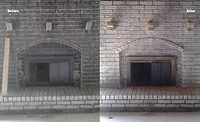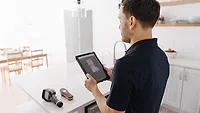Moisture Meters: Breaking Down the Types & Uses
Find the right tools to accurately troubleshoot moisture content problems
Technology is advancing at a fast pace in our ever-changing water damage restoration industry. However, even with these innovative changes, moisture content measurement will always remain a critical component.
When the accuracy of these measurements can affect your success rate and your reputation, advanced technology is always worth discussing.
Moisture meters today are designed to deal with annoying obstacles that bombard us on an ongoing basis. For example, some manufacturing companies are now including a “press and hold” function, with which the meter will hold the display for a short time after it has been removed in the event that the contractor cannot view the results right away due to darkness or tight spaces.
Data Collection Moisture Meters
Data collection meters have also benefited from some pretty amazing updates. Most data collection meters fit directly in the palm of your hand, and some actually integrate with Bluetooth® technology.
Newly designed data collection devices can collect and store information internally, or download information onto a standard SD card. Restoration professionals also have the choice of storing information from multiple job sites onto one card. Individual SD cards can also be swapped out to record and maintain complete records for each job site.
Some data collection meters enable data to be transferred directly through a USB port or SD card reader. Collected data can then be exported to an Excel spreadsheet for ongoing data analysis.
These new features can offer great solutions for restoration professionals when data analysis is critical by providing statistical analysis information and backup documentation that is essential in complying with ASTM F2170. This makes it much easier to follow the standard the way it’s intended to be followed, giving customers peace of mind.
Concrete Moisture Testing
Concrete moisture testing has also come a long way, especially considering that at one time, we had to rely on several concrete moisture testing methods because one test could never reveal the whole picture.
Fortunately, concrete tests seem to have evolved around the needs of flooring professionals who rely on fast and accurate readings. Because concrete dries from the top down, spot checking the surface of the concrete with a moisture meter, although fast, hasn’t always provided accurate results. The calcium chloride method and hood methods are also no longer recommended.
Today’s innovative technology now makes it possible to obtain accurate and immediate results with systems that integrate with relative humidity sensors. These self-contained sensors can be drilled and placed directly into a concrete slab at a depth of 40% of the slab’s thickness.
Once the sensor has been installed and allowed to equilibrate and acclimate, readings provide an accurate moisture measurement of the concrete that provides compulsory information for ASTM-compliant reports.
Smart Sensors
Smart sensors now come in reusable or single-use applications. Single-use sensors remain in the test hole once they are inserted, allowing continuous monitoring to take place over a long period of time.
The advantages of single-use sensors include:
- accurate measurement
- lower cost per test
- minimal site preparation (avoids cleanup and removal)
- saving time
Reusable smart sensors lower your cost per test every time you use them, but are more expensive than single-use sensors. Even though these sensors can be re-used, a calibration check is required within 30 days prior to testing, which can take several hours per sensor. (The ASTM F2170 requires annual recertification of calibration on all reusable sensors)
Some restoration professionals prefer reusable sensors if they have larger jobs that require frequent testing.
Mobile Devices for Industry Experts
And last but not least, the phrase “there’s an app for that” has finally entered into our playing field. For those of us who are always looking for an excuse to use our mobile devices, the options to calculate moisture content are here.
Wood flooring installers are asking for apps to calculate EMC. These apps should provide solutions and additional information on common moisture-related problems. Manuals and other moisture related resources should be accessible no matter what type of mobile device the contractor is using.
For those working with concrete, such as flooring installers, general contractors, and spec providers, they are seeking out apps that provide immediate access to the latest relative humidity (RH%) thresholds for flooring adhesives, coatings, finished floor products, or remediation products.
Cutting edge equipment that provides accurate information and troubleshoots moisture problems doesn’t have to be complicated or expensive.
Now that sophisticated technology has become more accessible and more user-friendly, restoration professionals can invest in devices they can count on with accurate documentation, while finding peace of mind in knowing they can limit their risk from liability issues.
Looking for a reprint of this article?
From high-res PDFs to custom plaques, order your copy today!





